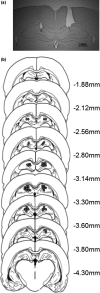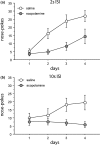Infusions of scopolamine in dorsal hippocampus reduce anticipatory responding in an appetitive trace conditioning procedure
- PMID: 30378776
- PMCID: PMC6305963
- DOI: 10.1002/brb3.1147
Infusions of scopolamine in dorsal hippocampus reduce anticipatory responding in an appetitive trace conditioning procedure
Abstract
Introduction: Trace conditioning is impaired by lesions to dorsal hippocampus, as well as by treatment with the muscarinic acetylcholine antagonist scopolamine. However, the role of muscarinic receptors within hippocampus has received little attention.
Methods: The present study examined the effects of intra-hippocampal infusion of scopolamine (30 µg/side) in an appetitive (2 vs. 10 s) trace conditioning procedure using sucrose pellets as the unconditioned stimulus (US). Locomotor activity (LMA) was examined in a different apparatus.
Results: Intra-hippocampal scopolamine reduced responding to the 2 s trace conditioned stimulus (CS). Intra-hippocampal scopolamine similarly depressed responding within the inter-stimulus interval (ISI) at both 2 and 10 s trace intervals, but there was no such effect in the inter-trial interval. There was also some overall reduction in responding when the US was delivered; significant at the 10 s but not at the 2 s trace interval. A similar pattern of results to that seen in response to the CS during acquisition was shown drug-free (in the 5 s post-CS) in the extinction tests of conditioned responding. LMA was increased under scopolamine.
Conclusions: The results suggest that nonspecific changes in activity or motivation to respond for the US cannot explain the reduction in trace conditioning as measured by reduced CS responding and in the ISI. Rather, the findings of the present study point to the importance of associative aspects of the task in determining its sensitivity to the effects of scopolamine, suggesting that muscarinic receptors in the hippocampus are important modulators of short-term working memory.
Keywords: dorsal hippocampus; rat; scopolamine; trace conditioning.
© 2018 The Authors. Brain and Behavior published by Wiley Periodicals, Inc.
Figures




Similar articles
-
Scopolamine Impairs Appetitive But Not Aversive Trace Conditioning: Role of the Medial Prefrontal Cortex.J Neurosci. 2017 Jun 28;37(26):6289-6298. doi: 10.1523/JNEUROSCI.3308-16.2017. Epub 2017 May 30. J Neurosci. 2017. PMID: 28559376 Free PMC article.
-
Estrous cycle stage gates sex differences in prefrontal muscarinic control of fear memory formation.Neurobiol Learn Mem. 2019 May;161:26-36. doi: 10.1016/j.nlm.2019.03.001. Epub 2019 Mar 6. Neurobiol Learn Mem. 2019. PMID: 30851433
-
Muscarinic receptors activity in the perirhinal cortex and hippocampus has differential involvement in the formation of recognition memory.Neurobiol Learn Mem. 2012 May;97(4):418-24. doi: 10.1016/j.nlm.2012.03.006. Epub 2012 Mar 20. Neurobiol Learn Mem. 2012. PMID: 22452926
-
Scopolamine disruption of behavioral and hippocampal responses in appetitive trace classical conditioning.Behav Brain Res. 1999 Apr;100(1-2):143-51. doi: 10.1016/s0166-4328(98)00123-5. Behav Brain Res. 1999. PMID: 10212061
-
Cholinergic transmission in the dorsal hippocampus modulates trace but not delay fear conditioning.Neurobiol Learn Mem. 2010 Sep;94(2):206-13. doi: 10.1016/j.nlm.2010.05.008. Epub 2010 Jun 2. Neurobiol Learn Mem. 2010. PMID: 20685338
Cited by
-
Age-related differences in appetitive trace conditioning and novel object recognition procedures.Neurobiol Learn Mem. 2019 Oct;164:107041. doi: 10.1016/j.nlm.2019.107041. Epub 2019 Jul 24. Neurobiol Learn Mem. 2019. PMID: 31351120 Free PMC article.
-
Training on an Appetitive Trace-Conditioning Task Increases Adult Hippocampal Neurogenesis and the Expression of Arc, Erk and CREB Proteins in the Dorsal Hippocampus.Front Cell Neurosci. 2020 Apr 17;14:89. doi: 10.3389/fncel.2020.00089. eCollection 2020. Front Cell Neurosci. 2020. PMID: 32362814 Free PMC article.
References
-
- Baeyens, F. , Vansteenwegen, D. , Hermans, D. , Vervliet, B. , & Eelen, P. (2001). Sequential and simultaneous feature positive discriminations: Occasion setting and configural learning in human Pavlovian conditioning. Journal of Experimental Psychology: Animal Behavior Processes, 27, 279–295. 10.1037/0097-7403.27.3.279 - DOI - PubMed
Publication types
MeSH terms
Substances
Grants and funding
LinkOut - more resources
Full Text Sources

